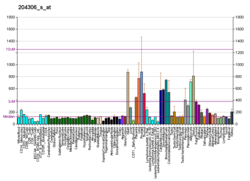Top Qs
Timeline
Chat
Perspective
CD151
Protein-coding gene in humans From Wikipedia, the free encyclopedia
Remove ads
CD151 molecule (Raph blood group), also known as CD151 (Cluster of Differentiation 151), is a human gene.[5]
Remove ads
Function
The protein encoded by this gene is a member of the transmembrane 4 superfamily, also known as the tetraspanin family. Most of these members are cell-surface proteins that are characterized by the presence of four hydrophobic domains. The proteins mediate signal transduction events that play a role in the regulation of cell development, activation, growth and motility. This encoded protein is a cell surface glycoprotein that is known to complex with integrins and other transmembrane 4 superfamily proteins. It is involved in cellular processes including cell adhesion and may regulate integrin trafficking and/or function. This protein enhances cell motility, invasion and metastasis of cancer cells. Multiple alternatively spliced transcript variants that encode the same protein have been described for this gene.[5] Abnormalities in CD151 have been implicated in a form of epidermolysis bullosa.[6][7]
Remove ads
Interactions

See also
References
Further reading
External links
Wikiwand - on
Seamless Wikipedia browsing. On steroids.
Remove ads





